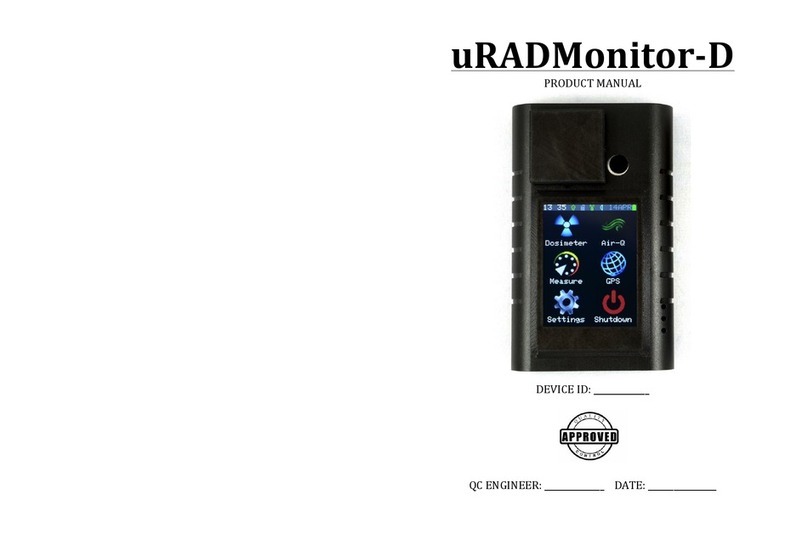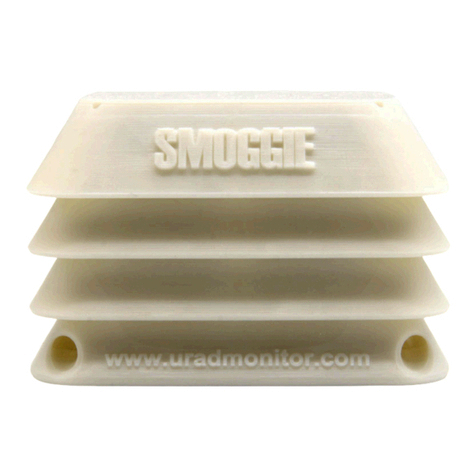
reset
Format: "reset"
Call example: "reset"
Description: will reboot the uRADMonitor device
setmute
Format: "setmute","1|0"
Call example: "setmute","1"
Description: toggles the speaker on (0) or off (1).
Default value is 0, so the speaker is active by
default.
powersave
Format: "powersave","1|0"
Call example: "powersave","1"
Description: toggles the powersave mode on (1) or
off (0). Default is off. If enabled, the device
will send measurements data then go to sleep
immediately, for the "sendint" interval, to conserve
power. A LoRaWAN INDUSTRIAL device comes
about 500mW in normal mode and an average of
10mW with sleep mode enabled. This feature is
useful when running on limited power.
key1
Format: "key1","value"
Call example: "key2","WLAN-SSID"
Description: this is a multipurpose parameter
depending on uRADMonitor device type:
•WIFI: it holds the SSID of the Wifi
network the device should connect to.
•LoRaWAN with ABP join: it holds the
DEVADDR.
•GSM: it holds the GPRS APN .
This command allows you to configure the key1
value. Maximum key length is 64 characters.
key2
Format: "key2","value"
Call example: "key2","WLAN-KEY"
Description: this is a multipurpose parameter
depending on uRADMonitor device type:
•WIFI: it holds the key of the Wifi network
the device should connect to.
•LoRaWAN with ABP join: it holds the
NWKSKEY.
•LoRaWAN with OTAA join: it holds the
APPEUI.
•GSM: it holds the GPRS user (if any).
This command allows you to configure the key2
value. Maximum key length is 64 characters.
key3
Format: "key3","value"
Call example: "key3","APPSKEY"
Description: this is a multipurpose parameter
depending on uRADMonitor device type:
•LoRaWAN with ABP join: it holds the
APPSKEY.
•LoRaWAN with OTAA join: it holds the
APPKEY.
•GSM: it holds the GPRS password (if
any) .
This command allows you to configure the key3
value. Maximum key length is 64 characters.
beep
Format: "beep"
Call example: "beep" or beep
Description: if mute is off, will produce a short beep
on the speaker
alarm
Format: "alarm"
Call example: "alarm"
Description: if mute is off, will activate the sound
alarm for about a minute or until the command is
called the second time.
key4
Format: "key4","value"
Call example: "key4","PINCODE"
Description: this is a multipurpose parameter
depending on uRADMonitor device type. Currently it
is only used by GSM devices, where the value
represents the SIM CARD PIN code (if any).
This command allows you to configure the key4
value. Maximum key length is 64 characters.
server
Format: "server","value"
Call example: "server","data.uradmonitor.com"
Description: on devices with Ethernet, WIFI or
GSM, this command sets the server the payload
should be sent to. This powerful command allows to
redirect payloads to other destinations then the
default uRADMonitor data server. Please do not
change unless you know what you are doing.
Maximum length is 64 characters.
script
Format: "script","value"
Call example: "script"," /api/v1/upload/e7/"
Description: on devices with Ethernet, WIFI or
GSM, this command sets the script the payload
should be sent to. This powerful command allows to
redirect payloads to other destinations then the
default uRADMonitor data server. Please do not
change unless you know what you are doing. Max
length is 64 characters.
rx1delay
Format: "rx1delay","value"
Call example: "rx1delay","4000"
Description: sets the LoRaWAN RX1 window, in
miliseconds. RX2 will be automatically set to RX1 +
1000ms.
lorajoin
Format: "lorajoin","1|2"
Call example: "lorajoin","1"
Description: sets the LoRaWAN JOIN mode, where
1 is OTAA and 2 is ABP.
loradr
Format: "loradr","value|255"
Call example: "loradr","0"
Description: sets the LoRaWAN data rate at device
startup. Use 255 for no change (DR remains on
previous setting). Value interval is from 5 (SF7) to 0
(SF12).
loraadr
Format: "loraadr","value"
Call example: "loradr","0|1|255"
Description: Toggles the LoRaWAN adaptive data
rate at device startup, 1 to enable ADR, 0 to disable
ADR. Use 255 for no change (ADR remains on
previous setting).
loraupctr
Format: "loraupctr","value"
Call example: "loraupctr","1055"
Description: Sets the UP Counter used with
LoRaWAN ABP. the next message sent to the
Gateway will have the counter value+1.
getsettings
Format: "getsettings"
Call example: "getsettings" or getsettings
Description: returns the device configuration in
JSON format
getdata
Format: "getdata"
Call example: "getdata" or getdata
Description: returns the last device data in JSON
format. Please note that while USB is connected,
the device is in powersave mode and all sensors
are disabled.





























